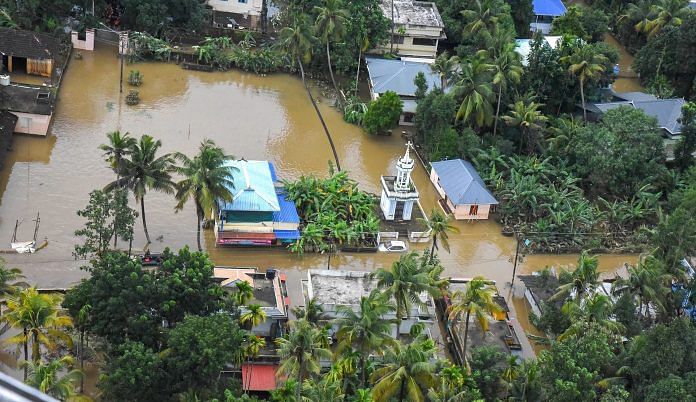After being marooned for days, Kochi residents say the city needs better planning and removal of illegal encroachment over canals.
Kochi: The commercial capital of Kerala was cut off from most parts of the country for days as the southern state faced its worst floods in nearly a century. Public transport collapsed, drainage canals in the low-lying areas flowed over and the Periyar river burst at the seams to flood many parts of the bustling city.
Now, as Kochi begins to pick up the pieces in the aftermath, experts and residents are trying to understand the lessons from the visible destruction — particularly the need for better planning and removal of illegal encroachment over canals.
Gopakumar, an architect who heads citizen association Better Kochi Response Group, pointed to the baggage of urbanisation blamed for some of the flooding.
“The waterways are blocked, the canals in the city have been reduced in depth and width with illegal constructions over them. This has led to slower drainage of water into the Arabian Sea. Look at the canals in Panampilly Nagar and Edappally, they are so narrow that when these floods took place there was no space for the water to flow out,” he said.
“This time it was heavy rains and the dams had to be opened. Next time, it could be worse. We all are sitting on a watery volcano which would burst at any time,” Gopakumar said.
Also read: After the flood and a 14-day shutdown, how to fix Kochi airport
Marooned
The city, one of India’s most popular tourist destinations, literally came to a standstill after its rail, road and air links were snapped for nearly 48 hours.
The municipality of Aluva, located along the Periyar around 15 km from the city, witnessed an unprecedented flash flood and faced the maximum brunt with uprooted trees, partially collapsed houses, flipped cars, snapped power lines and overflowing sewage drains.
The areas around Paravoor and Perumbavoor too were marooned and many families remained trapped for days until the rescue personnel managed to bring them to makeshift camps. The connection to the city snapped and many finally relied on the recently-launched Kochi Metro, wherever it was able to operate, to move to safer zones near Ernakulam.
However, E.K. Bharat Bhushan, a former director-general of civil aviation (DGCA) who lives in Kochi, said the city was not completely cut off from the east and the north. And the south, especially towards the capital, was open. “The Thiruvananthapuram lines were open as the trains would end their journey at Ernakulam as Chalakudy was affected and Aluva was inundated. The north towards Munnar was completely cut off. Fortunately, the backwaters did not overflow,” he said.
Also read: A most unusual train journey through India’s traveller’s paradise
Canals, planning
The need of the hour is for the city to begin planning like Amsterdam and Malaysia, said Gopakumar. The maximum violations of the canals in Kochi have been by the railways. They have built over them without proper drainage and channeling, he alleged.
“We need to act now and learn from other countries. Look at Malaysia where architects have reorganised canals just as we reorganise roads. They have ensured that the waterways are not blocked. Similarly, in Amsterdam, the city has boats plying through. They have built bridges that are high and do not get affected if the water rises. Kochi can have floating roads too,” said Gopakumar.
Ravi Chander, another urban planning expert, said this has become the story of many of India’s cities. “You build in areas where you ought not to build. You even get incentives to build in such places which violate nature. People need dwellings, but it should not violate good environmental principles,” he said.
Several residents along Kadavanthara and Tripunithura, areas that were considered safer, had to wait for three days till the water receded from their houses. Haneef, who runs a Biriyani shop near Broadway street, was shocked when he saw water flowing over the bridge near his store. “I thought we would just drown,” he said.
Asked about the city’s need for better planning, Haneef, whose brother lost half his shop which was built over a storm water drain in Bengaluru, came up with an interesting suggestion, “Just like the city corporation cleared sewage drains in Bengaluru by demolishing houses that were illegally built over them, they should do that here too.”
Also read: Airfare for Kerala flights capped at Rs 10,000, but airlines couldn’t care less



